Department History
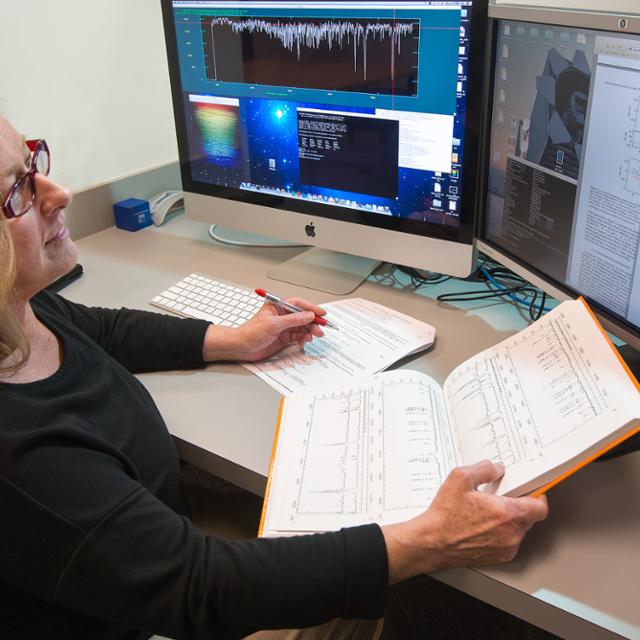
Physics has been taught at TCU since it was incorporated in 1873. Randolph Clark is listed in the historical records as the teacher of physics, math and natural science from 1873 to 1895. The first full-time physics professor was Dr. Newton Gaines, hired in 1924. At that time physics and chemistry were joint departments, but physics became an independent department in 1927-28 with Dr. Gaines as the first chairman.
In 1964, physics at TCU completed its 40th year with no special celebration, but the department was changing from a purely undergraduate teaching program comprised of two to three faculty members with an occasional master’s student to a new teacher-scholar faculty of nine who would continue to stress effective undergraduate teaching while significantly increasing graduate teaching and research. The Ph.D. program was now well underway having graduated three students in its first four years. To strengthen the undergraduate program and better prepare students for the demands of graduate research, the BS track in physics was established in 1963-64 to provide a more physics intensive alternative to the traditional BA degree.
Dr. H. Miller Moseley was hired in 1950 and served TCU for 40 years until retiring in 1990. Dr. Moseley received his BA degree from TCU in 1943 and his Ph.D. from University of North Carolina in 1950. Dr. Moseley was meticulously well organized. He was often known to begin a lecture writing in the upper left hand corner of the blackboard and finishing his derivation at the lower right end at precisely 50 minutes. He would consistently distinguish in his careful pronunciation lower and upper case omega so the students could better follow his lecture. In his early years at TCU, Dr. Moseley was in charge of advanced labs in mechanics and thermodynamics. He was careful with lab equipment and built wooden storage boxes to fit all the apparatus he would use in the labs. Today, most of the boxes have been lost, but occasionally you may come across one in a storeroom, a nicely varnished natural colored wooden box with a hinged top and a neat hand written label to remind you of Dr. Moseley.
Dr. Gaines received his BS in electrical engineering from UT Austin in 1912 and his Ph.D. from UT Austin in 1931, after he had already been teaching at TCU for seven years. Dr. Gaines’ research was in an area known today as biophysics. He investigated the effects of ultrasound on bacteria and found an effective way to sterilize milk with ultrasound. He had several publications in the early thirties in this area. Dr. Gaines was very active in the Texas Folklore Society and was an expert in cowboy songs. Every year he would don his cowboy outfit, including elaborate chaps and a ten-gallon hat, and sing his favorite cowboy songs, accompanying himself on the guitar. He was also known as an expert in throwing boomerangs and describing their behavior. Equipment was rare and perhaps more valued in those earlier days. Dr. Gaines would stencil “stolen from TCU Physics department” on all of the department equipment and you may still come across a few items with this reminder of the earlier days. He also wrote notes in shorthand on many items that only he could read, however until 1941, physics at TCU was a “one man” department so there wasn’t anyone else who needed to read the notes. Dr. Gaines continued to serve as department chair until his retirement in 1958.
Dr. Joseph Morgan was hired in 1941 and continued at TCU until his retirement in 1978, serving as chair when Dr. Gaines retired and moving into the role of vice president of the former TCU Research Foundation in 1971. Dr. Morgan was born in Kiev, Russia, raised in Philadelphia, and received his BA and MA degrees from Temple University. He received his Ph.D. from MIT in 1937 and spent a number of years at TAMU before coming to TCU. Dr. Morgan’s scholarly work was evident by his many published textbooks. He published Introduction to Geometrical and Physical Optics in 1953 and a two volume Introduction to University Physics text in 1969. A unique feature of his texts was his idea of giving parallel derivations of important formulas using calculus and non-calculus approaches. This was a very useful pedagogical approach and sadly has not been widely used by current authors. Dr. Morgan had a lifelong interest in serious music, and played the violin. He published his last text, The Physical Basis of Musical Sound, in 1979, after his retirement. He developed the physics of music course and pioneered physics for non-science majors at TCU. For many years, his sophomore optics course was considered by students to be the course that separated the “serious” physics majors from the rest.
Dr. Morgan was instrumental in developing the Ph.D. program in physics, which was inaugurated in 1960. TCU was the fourth university in Texas to offer a Ph.D. in physics, following UT Austin, TAMU and Rice University. The first Ph.D. degree was awarded to Dr. Richard Lysiak in 1963. The beginning of the Ph.D. program added the expectation of serious scholarly research to the faculty’s agenda and the TCU ideal of the teacher-scholar was launched.
In 1952, the Department and the other science programs moved into the new science
building, Winton Scott Hall. Physics occupied the entire first floor with new lab
space, a large lecture hall, ample office space and room to expand.
The addition of a Ph.D. program required the addition of new faculty and a triggered
a growth spurt in the department. Dr. Leo Baggerly, who earned a Ph.D. in nuclear
physics from CalTech, was hired in 1958 in anticipation of the new Ph.D. program.
Among the first pieces of major research equipment acquired in 1960 was a small accelerator
for development of a nuclear physics and later electron scattering research program.
In 1960, Dr. Prem Mahendroo, with a Ph.D. from UT Austin, and Dr. Palmer Edwards, with a Ph.D. from Florida, were hired. These additions expanded the research program of the department. Dr. Mahendroo’s research was in NMR and EPR, requiring a major piece of research equipment, and Dr. Edwards was a specialist in magnetic whiskers. In 1962, Dr. Richard Raeuchle, with a Ph.D. from Iowa, and Dr. Alex Hoffman, with a Ph.D. from UT Austin joined the faculty. Hoffman split his time between math, physics and working as the director of the computer center, while Dr. Raeuchle did research in x-ray diffraction. In 1963, Dr. Charles Blount, with his Ph.D. from TAMU, and Dr. Richard Lysiak, the first TCU Ph.D, joined the faculty. Dr. Blount was a specialist in atomic spectroscopy, requiring more major research equipment, and Dr. Lysiak, rather than continuing with NMR research, began a research program in Faraday rotation and later switched to non-linear optics.
Alumni and Former Faculty Features
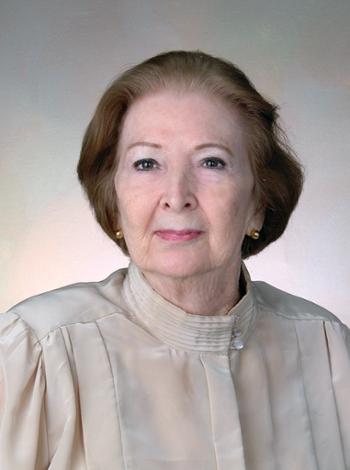
Charlotte LeMay’s family has been involved with TCU since its AddRan days. Her grandfather, William Alexander Darter, represented Fort Worth in its successful bid to bring TCU to the city and later served on the Board of Trustees. Her mother, Martha Adelia Darter Zihlman, her aunt, Frances Darter, and her younger sister, Blanche Darter Zihlman, graduated from TCU. Another aunt, Mary Sue Darter, chaired the art department.
But it was for financial reasons that she enrolled at the University. “My father was killed in an automobile accident in 1934,” she says. “The country was still very much in deep depression and our little family was ‘land poor‘ — lots of taxes but very little income.” Her mother studied at TCU to get a state teacher’s certificate, while substitute-teaching in the Fort Worth schools.
“In August of 1936, I went to see Prof. Gaines and told him I wanted to go to TCU and to major in physics,” she says. “I knew exactly what I wanted to do. Two weeks into the senior physics course at Paschal High School, I knew physics was my life’s work. Prof. Gaines listened, asked questions, and got me signed up as a National Youth Administration student doing stenographic work for the physics department. I lived at home and took the bus, which ran one block from my house, to TCU.”
In the late 1930s, the University offered a supportive environment for women in the sciences. “I was not aware of prejudice against females while I was at TCU,” Dr. LeMay recalls. “There were many women majoring in biology, and at least one other than myself in chemistry. Prof. Gaines’ own daughter, Betty, graduated in geology in 1942. If we made the grades, we were accepted as equals. I was even voted the ‘Most Representative Student in Physics’ in 1939.” Dr. LeMay graduated with a triple major — physics, chemistry and mathematics. When she applied to graduate schools, once again Prof. Gaines stepped in. “He had faith in me and wrote so many letters of recommendation trying to get me funding for graduate school,” Dr. LeMay notes. “This was before World War II and men elsewhere were definitely favored for scholarships.”
Mt. Holyoke College in South Hadley, Massachusetts, offered her the Otis Skinner Fellowship in Physics. “It was quite a change for the girl who had been out of Texas only once before,” Dr. LeMay recalls. She earned the MA in physics from Mt. Holyoke in 1941, and was admitted to Columbia University.
At Columbia, she took courses under Edward Teller and Enrico Fermi. In the summer of 1942, she was given the responsibility for a physics class at Hunter College. “I could load the students into the 11-story elevator and let them experience (in the pits of their stomachs) the concepts of acceleration and deceleration,” she remembers. “That was a wonderful summer!”
Because of the war, Teller and Fermi moved on to Chicago, and in 1943 Columbia ceased giving graduate courses beyond the first year. Dr. LeMay took a position at Monsanto Chemical Company’s facility in Springfield, Massachusetts, working to develop a plastic for radar domes. One morning in the pool-car going to the plant, she heard a “beautiful Texas twang” and discovered that the voice belonged to Jack LeMay. “That is how I met my husband-to-be,” she recalls. Six months later, they married.
When WWII ended, Jack LeMay, an engineer, went to work for Union Carbide Corp. and was sent to Baton Rouge, Louisiana. Charlotte LeMay was hired by Louisiana State University, where she taught premed physics students who were returning from war on the GI Bill of Rights —110 of them. “All were trying to get into medical school at the same time and had to take a year of physics,” she remembers. “You never saw such competition!” At LSU, Dr. LeMay did experimental work under Prof. George Jaffé, who had worked under Marie Curie. She earned the Ph.D. in physics from LSU in 1950, when her first child was five years old.
After several transfers, the LeMays, now with two sons, moved to Dallas. Dr. LeMay contacted Texas Instruments and was told that they weren’t hiring women except for assembly line work. When Jack LeMay, still with Union Carbide, called on the director of TI’s semiconductor division, he mentioned that his wife had finished her doctorate doing work on dielectric liquids. “Tell her to phone me,” he was told. Soon Charlotte LeMay became the fifth “man” in the semiconductor division. “TI ‘pulled’ its first germanium crystal, made its first transistor, according to Bell Lab’s directions, and we were in business,” she recalls.
Jack LeMay, who passed away in 1998, spent most of his career with Union Carbide. At that time, people who worked for large corporations frequently were transferred. Consequently, the family moved from Dallas to California, where Dr. LeMay worked for the Stanford Research Institute. After one year, they were transferred back to Dallas, and Dr. LeMay again worked for TI.
While she was in California, TI had obtained very pure silicon for the first time. Silicon was abundant in nature as a compound, ordinary sand, but it had not previously been purified enough as a single element to be used as a semiconductor. She used the new silicon to make the world’s first silicon transistor. “We notified the right people in the government, and the next day, five men in uniforms were in our lab,” she remembers. “They had flown down over night. We had never seen so much gold braid!”
The next move was to Pittsburgh — now with three children, two boys and a girl. Dr. LeMay worked for Westinghouse as one of three “men” who made the first silicon carbide transistor. “Though by modern standards it was not small, for that time it was,” Dr. LeMay notes. “I was able to take a picture of it through the eye of a needle.”
In 1960, the family was transferred to New York, where Dr. LeMay went to work for IBM’s Watson Research Laboratory. After three years, she decided to return to teaching. Dr. LeMay chaired the physics department at Western Connecticut State University in Danbury, Connecticut, for 12 years. She is now retired and lives in Nokomis, Florida.
Prof. Newton Gaines has remained an influence throughout her life. “Two things that I learned from Dr. Gaines that were not strictly physics were, first, people feel honored to help you with something, if you know what you want, and, second, never be afraid. You can do anything you want to do, if you make up your mind to do it. Many years later, when I was chairman of a department of physics in Danbury, Connecticut, there were four physics majors doing their senior projects. When they knew exactly what they needed, I went to companies in the area and told the company people what the projects required. The companies were always gracious about helping us and would never let me pay them.”
“That second point — be confident in yourself — has many times been the only thing that kept me going. When you start something, finish it.”
Dr. LeMay created the Professor Newton Gaines Scholarship through a gift of real estate. “There are only a few days of pure joy in a person’s lifetime, but January 24, 2002, was one for me,” Dr. LeMay says. “ It was the day I signed the documents transferring ownership of the second lot in Westchester County, New York, to Texas Christian University. I was finally paying back a little on the gift of faith that TCU had given to me. I was so happy!”
Joseph Morgan (1909-1994), who spent most of his academic career at TCU, was a major influence on the development of the Department of Physics and the furtherance of science at the University. He is remembered with fondness and respect by colleagues who served with him on the faculty and by the many undergraduate and graduate students who learned physics from him.
Born in Kiev Russia, Morgan came to the United States at an early age to settle in Philadelphia where he received his early education. After earning the A.B. in 1931 and M.A. in 1933 from Temple University, he attended the Massachusetts Institute of Technology, where he received the Ph.D. in physics in 1937. Coming to TCU as assistant professor in 1941, he rose to full professor in 1945. He served as director of the Engineering Program in 195 1, chairman of the Science Division (1953-55), chairman of the Department of Physics (1958-69), and vice president of the TCU Research Foundation from (1969-78). Dr. Morgan was a Fellow of the American Physical Society and selected Professor of the Year in 1960. He was the author of numerous articles and six textbooks. A student of the violin from an early age when he played in a junior orchestra under famed Philadelphia Orchestra conductor, Arthur Rodzinski, he had a lifelong passion for music.
As a principal architect of the physics department, during his tenure as professor and chairman, and a strong supporter of graduate studies at the University while vice-president of the TCU Research Foundation, Joseph Morgan made significant contributions to the development and growth of research at the University. The Joseph Morgan Lectures inaugurated in 1995 are intended to reflect his broad interests in scholarly activities and his particular delight in research seminars.
Development of the Joseph Morgan Lecture
Endowment of a lecture series to honor the memory of Dr. Joseph Morgan was first suggested shortly after Dr. Morgan’s death in 1994 by Dr. Ira Lon Morgan (A.B. 1949), one of Dr. Morgan’s early students at TCU. The Department of Physics supported the lecture series during its first several years while the endowment grew toward its goal with contributions from former students, friends and department faculty. Especially important in this growth was a bequest from Arlynn Purvis. Lynn had his B.A. in physics from TCU in 1958 and his M.A. in 1961. Lynn was a long time supporter of the physics department, attended the inaugural Morgan lecture and his bequest brought the lectureship endowment to fruition after his untimely death in 1998. The endowment needs to continue to grow and contributions from friends of the TCU Department of Physics and Astronomy are always welcome and encouraged.
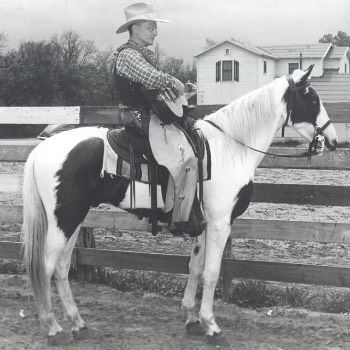
In 1928, physics became a separate department offering a major, and Dr. Gaines became chairman, a position he held until his retirement in 1958. “With diligence and dogged determination he has collected apparatus,” Dean Hall observed, “buying to the limit of the budget, securing more secondhand and remaking it, until the laboratory has become quite extensive.”
Dr. Charlotte LeMay ’40, who has endowed a scholarship named for Dr. Gaines, recalls his creativity and commitment to building a first-rate physics program. “Because what little money there might be available for equipment — I emphasize might — went to purchase laboratory pieces for general physics, there was very little left over for demonstrations or lab equipment for other classes. Here is where his ingenuity shown brightest. In the stock room were many cardboard boxes, each labeled, which held all sorts of things. Unless you had seen them put together to demonstrate some principle of physics, you would have no idea what they could be used for. And often he was the only one who knew how to put them together, but they worked!
“Many people, some not directly associated with the campus, used his facilities. They came into the space, did their thing, waved to him, and went out again. As a precaution, he had marked everything that might have disappeared otherwise, with the words ‘Stolen from TCU.’ It was effective. As one of the gifts at his retirement luncheon, he received a very good, brand-new pocketknife, also marked ‘Stolen from TCU.’ He had a great laugh over that!”
A distinguished researcher, Dr. Gaines was the model of the teacher-scholar that persists at TCU to this day. As Dean Hall observed, “Dr. Gaines, despite his heavy load of teaching, has produced as a scientist, having worked out a suggestion into practical application on the use of super-sonic sound waves in the treatment of bacteria.” A 1931 issue of Science News described one experiment: “Audible sound waves, so high-pitched and so intense as to be best described as a ‘terrific squeak,’ have been used to kill bacteria by…Prof. Newton Gaines of Texas Christian University, physicist.” As a result of his work, Dr. Gaines held the patents for pasteurizing milk by using ultrasound.
But what made Newton Gaines most memorable was what Dean Hall described as that “sentiment in his soul also for art and Southwest folklore.” A longtime member of the Texas Folklore Society, Dr. Gaines served as its president in 1928. “He was 100 percent Texan! He talked it, walked it and thought it,” comments Dr. LeMay. “Above all else, he loved to entertain an audience.
“He was an authority on working cowboy songs, the ones the cowboys sang to move the cattle such as ‘Get Along Little Doggie,’ and they were timed by the horse’s pace. Some songs were sung at night to bed the cattle down. Sometime before I met him, he had recorded songs on an old hill-and-dale quarter-inch thick record — I think it was an Edison Red Seal label.
“He took every legitimate opportunity to entertain his classes. Every spring, usually in April, there would be an article in the Sunday Fort Worth Star-Telegram about Prof. Gaines, who would go out to a high point on campus and throw boomerangs. He was usually dressed in a kilt and wore a many-colored cap with a red topknot. He was very good at throwing boomerangs.”
Dr. Gaines also held an appointment to the music faculty, where he taught the physics of music for two decades. “This course was required of all students who majored in music,” Dr. LeMay remembers. “Prof. Gaines teased that some day he was going to give a course in the physics of dancing for ballerinas.
“There were numerous musical instruments stored in the physics department’s space. There was even a piano, which was often played by the students except when Professor Gaines was ‘in his private office.’ Since his real office could not be closed off from sound, his ‘private office’ was indicated when he donned a bookkeeper’s green eyeshade.
“He was a dedicated teacher and gave of his time and energy to many people, both on and off campus. He was very much a pragmatist about all things and also believed in knowing as much as one could.
“With impossible amounts of hard work, the support of a charming wife, and the help and good will of his peers, Prof. Gaines made and improved a physics department in the middle of the worst depression this country has ever known.”
This story first appeared in the Fort Worth Star-Telegram on 9/11/2014
Written by Patrick M. Walker
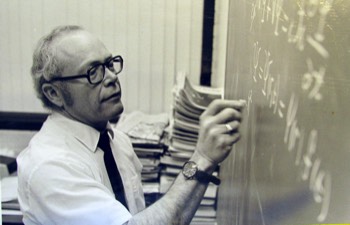
You have a bright future, young man. Everyone is pulling for you.
For the next 75 years or so, Mr. Moseley would make a prophet of his mentor. A talented mathematician, he was valedictorian of his class at the Fort Worth Masonic Home, then went to TCU on scholarship and finished at the top of his class there, too.
He took his undergraduate degree in physics and chemistry to the University of North Carolina at Chapel Hill and began working toward a doctorate under the guidance of Nathan Rosen, a collaborator of Albert Einstein’s. When Einstein asked Rosen to join his team for the Manhattan Project, Rosen took his prized pupil with him.
After the war, Mr. Moseley finished his doctorate and returned to Fort Worth, where he landed a job teaching at TCU. Except for a year’s sabbatical doing research at Oak Ridge National Laboratory in 1957-58, he would hold the job until his retirement in 1990.
None of it might have happened if not for that football coach, Rusty Russell, the legendary leader of the Masonic Home’s “Mighty Mites,” who, playing on undersized but overachieving squads, went toe-to-toe with the state’s powerhouses in the 1930s and early ’40s, capturing the nation’s heart along the way.
Mr. Moseley was 7 when his father died and his mother sent him and his brother and sister to live at the home on the city’s southeast side.
Growing up there would be a “transformative experience” for the siblings, who were from the Wichita Falls area, said Tom Kellam, Mr. Moseley’s nephew and the archivist for the Tarrant County College District.
“It was a huge thing that changed their lives,” said Kellam, whose mother was Mr. Moseley’s sister. “They never would have had the opportunities they had without it. They probably wouldn’t have been able to go to college.”
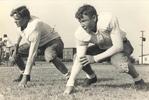 Mr. Moseley, who even among a roster of smaller players was one of the smallest, at
5-foot-8 and 124 pounds, was one of Russell’s favorite players, according to Jim Dent’s
2007 bestseller Twelve Mighty Orphans.
Mr. Moseley, who even among a roster of smaller players was one of the smallest, at
5-foot-8 and 124 pounds, was one of Russell’s favorite players, according to Jim Dent’s
2007 bestseller Twelve Mighty Orphans.
“You might just be the toughest football player in the state,” Russell wrote in that same letter to Mr. Moseley. “But what is most impressive about you is your drive in the classroom. Teachers at the Masonic Home have never seen a brighter student. I doubt you will find a better math student anywhere than Miller Moseley.”
On the field, Mr. Moseley was a nimble end, Dent wrote, who “slashed between defenders as if his feet were strapped to roller skates.”
He was often the target in the short passing game that Russell devised to help his diminutive players gain an advantage over larger opponents.
Dent described Mr. Moseley as “one of the most remarkable people in the history of Fort Worth, Texas.”
“Without this man, some of the nation’s history might not have happened,” Dent said. “He was just deep.”
For more on Dr. Miller Moseley, you can also read his alumni profile in TCU magazine.